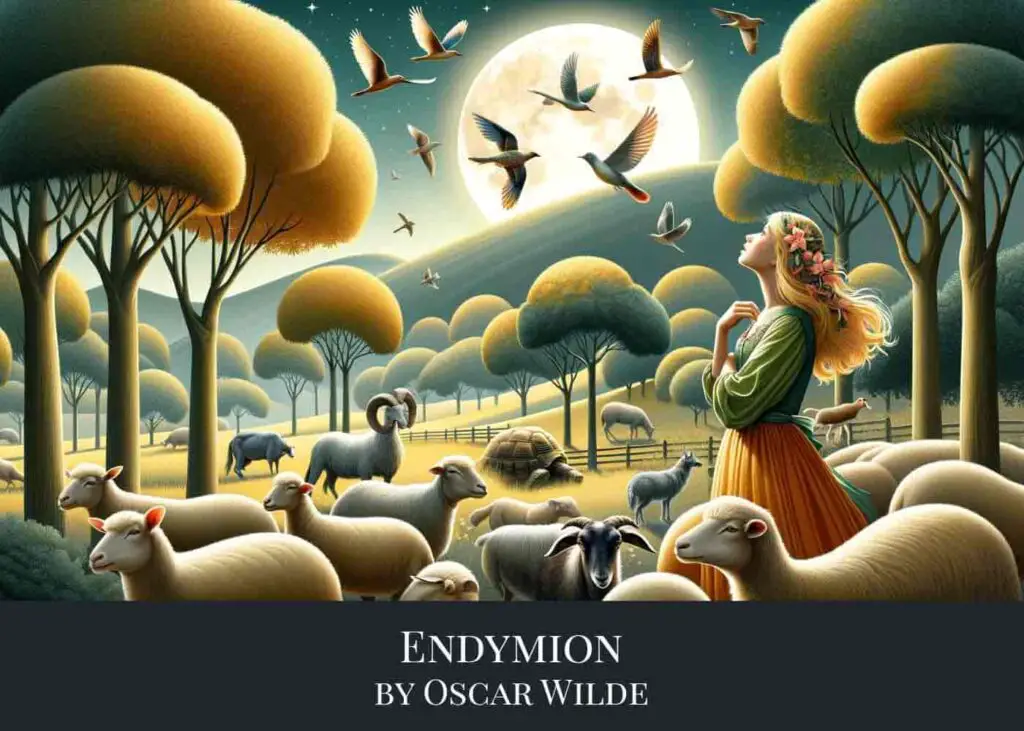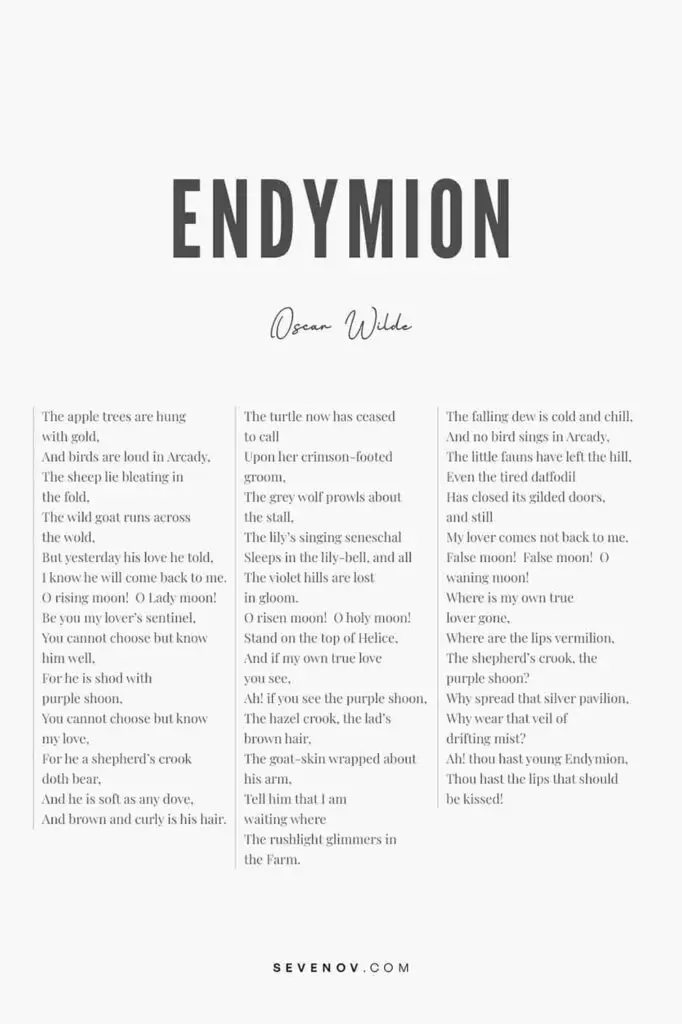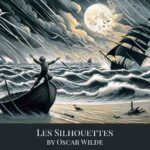
Endymion by Oscar Wilde
“Endymion,” a poem by poet and playwright Oscar Wilde, is a captivating piece in his poetry collection Poems. This poem is a beautiful example of Wilde’s early work, showcasing his lyrical prowess and fondness for mythological and pastoral imagery.
Set in the idyllic landscape of Arcady, a symbol of unspoiled natural beauty in Greek mythology, the poem tells the story of longing and love. The speaker, a woman, waits for her shepherd lover who has not returned. Her emotions are conveyed through vivid descriptions of the surrounding nature, moving from hopeful anticipation to deep despair as night progresses. The poem’s title refers to Endymion, a figure from Greek mythology, known for his eternal youth and beauty, and his love story with the Moon goddess Selene. Wilde’s use of this reference adds a layer of mythological depth to the poem, highlighting themes of unrequited love and longing.
Readers interested in exploring the rich tapestry of Wilde’s poetry can delve into Poems online book available at PageVio.
1. The Poem
The apple trees are hung with gold,
And birds are loud in Arcady,
The sheep lie bleating in the fold,
The wild goat runs across the wold,
But yesterday his love he told,
I know he will come back to me.
O rising moon! O Lady moon!
Be you my lover’s sentinel,
You cannot choose but know him well,
For he is shod with purple shoon,
You cannot choose but know my love,
For he a shepherd’s crook doth bear,
And he is soft as any dove,
And brown and curly is his hair.
The turtle now has ceased to call
Upon her crimson-footed groom,
The grey wolf prowls about the stall,
The lily’s singing seneschal
Sleeps in the lily-bell, and all
The violet hills are lost in gloom.
O risen moon! O holy moon!
Stand on the top of Helice,
And if my own true love you see,
Ah! if you see the purple shoon,
The hazel crook, the lad’s brown hair,
The goat-skin wrapped about his arm,
Tell him that I am waiting where
The rushlight glimmers in the Farm.
The falling dew is cold and chill,
And no bird sings in Arcady,
The little fauns have left the hill,
Even the tired daffodil
Has closed its gilded doors, and still
My lover comes not back to me.
False moon! False moon! O waning moon!
Where is my own true lover gone,
Where are the lips vermilion,
The shepherd’s crook, the purple shoon?
Why spread that silver pavilion,
Why wear that veil of drifting mist?
Ah! thou hast young Endymion,
Thou hast the lips that should be kissed!

Size: 8″ x 12″ (2:3 ratio)
Format: PDF
Copyright information: For personal use only
Note: Actual poster background color is white. For the sample poster, the background is made gray for illustration purpose.
2. Endymion Analysis
“Endymion” is a lyrical piece rich in imagery and emotion, set in a pastoral landscape, inspired by the idyllic settings of Arcady (Arcadia) in Greek mythology, a symbol of natural beauty and peaceful rural life.
The poem revolves around the theme of longing and love. The speaker, a woman, expresses a deep yearning for her lover who is a shepherd. The poem is structured into three stanzas, each reflecting a different time of day and a corresponding state of emotion.
First Stanza
This stanza paints a serene and golden scene with apple trees, loud birds, and bleating sheep. The wild goat’s movement across the open country contrasts with the stillness of the domesticated animals. The speaker reminisces about the lover who recently confessed his love, expressing faith that he will return to her. She appeals to the rising moon as a sentinel to watch for her lover, identifiable by his purple shoes, shepherd’s crook, gentle nature, and curly brown hair.
Second Stanza
Here, the atmosphere shifts to evening. The turtle dove and the grey wolf are introduced, and the lily’s seneschal (a steward or guardian) is mentioned, adding a touch of fairy-tale quality. The speaker’s tone becomes more imploring, asking the now fully risen moon to stand atop Helice (possibly a reference to a celestial body) and watch for her lover. She describes him further with a hazel crook and goat skin, indicating his shepherd’s life, and asks the moon to relay her message of waiting.
Third Stanza
In this final stanza, the mood turns somber and desolate. The dew is cold, birds no longer sing, and the fauns (mythical creatures) and daffodils have retreated, reflecting the speaker’s growing despair and loneliness. She accuses the waning moon of being false, as her lover has not returned. The reference to Endymion, a figure from Greek mythology who was loved by the Moon goddess Selene, adds a layer of mythological betrayal and unrequited love. The speaker feels abandoned, her longing unanswered.
The poem uses nature and mythological references to express deep emotional states, moving from hopeful longing to despair over a day, as reflected in the changing phases of the moon.
3. Conclusion
If you’re captivated by the lyrical beauty of Oscar Wilde’s ‘Endymion,’ with its vivid imagery of Arcady and heartfelt longing, you might enjoy exploring more of Wilde’s poetic works.




